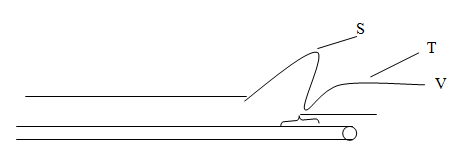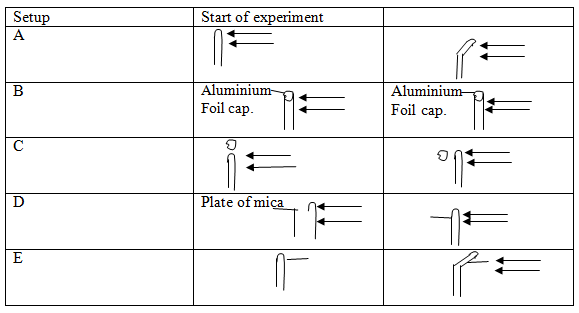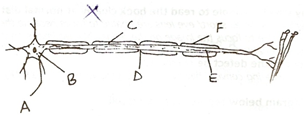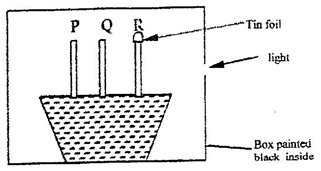Mastering KCSE Biology with Comprehensive Topical Questions and Answers
|
1. 1989 Q2 P1
State one structural and one functional difference between motor and sensory neurons. 2. 1990 Q15 P1 (a) How are the structures of the human eye adapted to their function?
Adaptation Function
(b) State three defects of the eye and explain how each can be corrected.
3. 1991 Q6 P1 The diagram below represents the changes in membranes potential during the propagation of an impulse along a nerve axon.
(a) Name the parts of the carve labelled S and T
(b) What is the distribution of ions across the nerve membrane at the region labeled V. 4. 1991 Q11 P1 In the experiment was set up to investigate the affect of unilateral light on the growth of oat coleoptiles. The diagram in the table represent the experimental set ups at the start, and the result at the end of the experiment,
a) Account for the results in the experiment set up A
b) Explain the purpose of experiment set ups B and C c) Explain the results in the experiment set ups D and E 5. 1992 Q 13 P1 The diagram below represents a simple reflex arc
(a) Name the parts labelled A and B
(b) Explain how an impulse is transmitted across the gap labelled C (c) Give three differences between nervous and hormonal communication 6. 1994 Q9 P1 Name the type of response exhibited by (a) Leaves of mimose pudica when they fold after being touched. (b) Euglena when it swims towards the source of light (c) Sperms when they swim towards the ovum. 7. 1994 Q15 P1 (a) The diagram below show a motor neuron
In the spaces provided below, give the letters that represents parts of the motor neuron described.
i)The body that carries impulse from the cell body ii) The structure that respond to acetylcholine i) The structure that contains the nucleus of the neurone ii) One of the cells that form the myelin sheath (b)What is the functional difference between motor and sensory neuron 8. 1994 Q16 P1 A person met a leopard as he walked a long a forest path. His adrenal glands secreted adrenaline to prepare him to run away. Explain how the following body sytems responded. (a) Circulatory system (b) Respiratory 9. 1995 Q14 P1 The diagram below represents growing seedlings which were subjected to unilateral light at the beginning of an experiment
(a) (i) State the results of P,Q and R after 5 days? (5 marks)
(ii) Account for your answer in (a) (i) above (3 marks) (b) If the tin foil were removed from the tip of the seedling R, what results would be observed after 2 days? (1 mark) (c) State the expected results after 3 days if the box were removed (1 mark) 10. 1996 Q16 P1 A shoot of seedling exposed to light on one side bends towards the source of light as it grows (a) Name the response exhibited by the shoot of the seedling (1 mark) (b) Explain how the bending towards the source of light occurs (3 marks) 11. 1997 Q5 P1 In an accident a victim suffered brain injury. Consequently he had loss of memory. Which part of the brain was damaged? 12. 1997 Q12 P1 A person was able to read a book clearly at arm’s length but at normal reading distance. a) State the defect the person suffered from? b) Why was he unable to read book clearly at normal distance c) How can the defect be corrected? 13. 1998 Q6 P1 In an experiment it was found that when maggots are exposed to light they move to dark areas. (a) Name the type of response exhibited by the maggots (b)Name the advantages of the response to the maggots 14. 1998 Q17 P1 The diagram below represents a nerve cell.
(a) (i) Identify the nerve cell.
(ii) Give a reason your answer in (a) (i) above (b) Name the structure labelled T (c) Using an arrow indicate on the diagram the direction of movement of an impulse in the cell. 15. 1999 Q6 P1 State three ways by which plants compensate for lack of ability to move from one place to another. 16. 2000 Q6 P1 What is the function of the following cell in the retina of human eye? Cones 17. 2003 Q15 A response exhibited by a certain plant tendril is illustrated below.
a) i) Name the type of response
ii) Explain how the response named in (a)(i) above occurs b) What is the importance of tactic responses to microscopic plants? c) State four applications of plant hormones in agriculture. 18. 2003 Q18 P1 Describe the functions of the various parts of the human eye. 19. 2004 Q6 P1 The diagram below shows the position of an image formed in a defective eye.
a) Name the defect:
b) Explain how the defect named in (a) above can be corrected (2 marks) 20. 2005 Q1 P1 Apart from hearing, state another function of the human ear. (1 mark) 21. 2005 Q19 P1 How is the human eye adapted to its function? (20 marks) 22. 2006 Q10 P1 State the important of tactic response among some members of kingdom protista. (1 mark) 23. 2006 Q21 P1 The diagram below represents a reflex are in human.
a) Name the parts labelled X and Y
b) Name the substance that is responsible for the transmission of an impulse across the synapse. (1 mark) 24. 2006 Q22 P1 a) State the function of ciliary muscles in the human eye. (1 mark) b) State two functional differences between the rods and cones in the human eye. (2 marks) 25. 2006 Q23 P1 State the function of each of the following parts of human ear. (4 marks) a) Ear ossicles b) Cochlea c) Semi circular canals d) Eustachian tube. 26. 2007 Q22 P1 (a) Where in the human body are relay neurons found (1 mark) (b) The diagram below represents a neurone (1 mark)
(i) Name the neurone (1 mark)
(ii) Name the parts labelled P and Q (2 marks) (c) State a function of myelin sheath (1 mark) 27. 2007 Q7 P2 Describe the structure and functions of the various parts of the human ear (20 marks) 28. 2008 Q13 P1 (a) Name the part of retina where image is formed (1 mark) (b) State two characteristics of the image formed on the retina (2 marks) 29. 2009 Q4 P2 (a) (i) Explain the changes that take place in the pupil and iris of a human eye when a person moves from a dark room to a room with bright light (3 marks) (ii) What is the significance of the changes explained in (a) above (1 mark) (b) How does the human eye obtain nutrients? (3 marks) (c) Explain why images that form on the blind spot are not perceived (2 marks) 30. 2010 Q6 P1 State one function for each of the following: a) Cerebellum (1 mark) b) Medulla oblongata (1 mark) 31. 2010 Q4 P2 The diagram below shows how the iris and pupil of a human eye appear under different conditions.
a) Name the structures labeled X and Y (2 marks)
X………… Y………… b) i) State the condition that leads to the change in appearance shown in the diagram labeled B (2 marks) ii) Describe the change that lead to the appearance of the iris and pupil as shown in the diagram labeled B. (4 marks) iii) What is the significance of the change described in (b) (ii) above? (1 mark) 32. 2011 Q28a P1 What is a tropic response 33. 2011 Q4 P2 (a) The diagram below represents a section of the human brain.
(i) Name the structures labeled P and R (2 marks)
(ii) State two functions of the part labeled Q. (b) (i) Name two reproductive hormones secreted by the pituitary gland in women (2 marks) (ii) State one function of each of the hormones named in (b) (i) above (2 marks) 34. 2011 Q8b P2 (a) Describe the exoskeleton and its functions in insects. (13 marks) (b) Describe how accommodation in the human eye is brought about when focusing on a near object. (7 marks) 35. 2012 Q9, 10 P1 9. State the importance of negative phototaxis to termites. (1 mark) 10. What is meant by the term irritability? (1 mark) 36. 2012 Q7 P2 Using a relevant example in each case, describe simple and conditional reflex actions. (20 marks) RELATED SEARCHESComments are closed.
|
Archives
December 2024
Categories
All
TOPICSFORM 1
Form 2
Form 3
Form 4
|
We Would Love to Have You Visit Soon! |
Hours24 HR Service
|
Telephone0728 450425
|
|
8-4-4 materialsLevels
Subjects
|
cbc materialsE.C.D.E
Lower Primary
Upper Primary
Lower Secondary
Upper Secondary
|
teacher support
Other Blogs
|



















 RSS Feed
RSS Feed